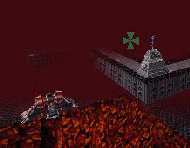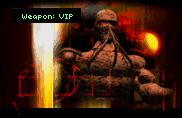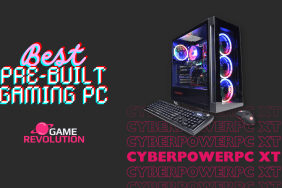Is it time to upgrade… again?
1996 marks the first year that the Microsoft Corporation, famed for its operating
systems, programming languages, and office utilities has decided to make a serious
appeal to the gaming market. Some of these titles, such as MS Golf, Monster
Truck Madness, and The Neverhood have been good approaches to the entertainment
genre. Other titles, such as Full Court Press and this particular title,
Hellbender, have not been so good.
Hellbender is an
arcade action-style ‘shoot-em-up’ and despite the fact that this reviewer normally
steers clear of such things in favor of more detailed flight simulator or strategy
programs, he is always open to any new, flashy action experience. This program
seemed to promise just that experience.
The plot of this game, as narrated by the opening video sequence, is to lead a one man crusade against an evil, interstellar robotic army intent upon conquest of Earth and its allied planets. The game takes place on the surfaces of several texture-mapped worlds, where the player flits around, breaking every speed limit, towards various navpoints. Targets are radar installations, bunkers, power stations, and supply depots. These can be destroyed by approaching from a distance, lining up the target in the crosshairs, and firing the onboard laser cannons until everything goes up in a fiery explosion. Other fighters will attempt to destroy you, but these can be easily terminated. One of the better features in this game is the ability to be able to punch the afterburners, accelerate into the atmosphere, and dogfight these pesky rogues above the clouds.
Backing up the game itself is a raucous, heavy-metal soundtrack interspersed every so often with warnings and advice from your E.V.E. onboard computer, voice courtesy of the X-Files’ Gillian Anderson. On the plus side, this game can be a visual and sound experience, capable of completely overwhelming the senses. Unfortunately, you need some massive hardware to find this out.
Let’s venture backwards about a year and a half…. Turn back the clock to the summer of 1995 and check out a hot new game called Terminal Velocity. This was a great game, with hot graphics, ear-piercing sound, and chaotic action. The plot was to lead a one man crusade
against an evil, interstellar robotic army intent upon the conquest of Earth and its allied planets. The player would fly around several texture-mapped planets, moving towards various waypoints and targeting power stations, radar installations, and supply depots. Every once in a while, the player would see attacking fighters, which he or she could afterburner up into the clouds to dogfight. Oh yes, and targets would vanish in fiery explosions, from being destroyed either by lasers, missiles, or collision.
Sound familiar? It should. Terminal Velocity enjoyed some brief success, until the engine and the game was bought from former Microsoft programmer/renegade Bruce Artwick by his old employers. A few tweaks, some new packaging, and suddenly by Christmas, the renamed Microsoft Fury appeared on store shelves. A year later, the sequel to this game, Hellbender, appeared.
 So what we have here is
So what we have here is
an original great game, repackaged and re-sold, sequeled, and sold again to
the exact same customers who may have bought Terminal Velocity a year
earlier. However, Microsoft did more than simply change the name. Gone is the
‘death by collision’ factor, as well as the sheer carnage that characterized
its predecessor. Also gone is some of the playability. I fail to understand
how the exact same graphics that once worked so well even on an old 486 DX2-66
with four, yes 4 megs of RAM, now requires a Pentium with a 3D Accelerator card
(that I don’t have). Even on a Pentium 90 with 16 Megs of Ram, an 8X Speed CD-ROM,
and a 2 Meg Video Card (my home computer), this game was so choppy that I could
actually watch the action in slow-motion, frame by frame. Granted, it does run
more smoothly in the lowest graphics mode, if you can ignore the fact that it
looks terrible. Now I did mention that the game could be an experience, and
on one of the GR office computers, it was. On a Pentium 133 with the aforementioned
3D card, the game looked terrific (the P133 without the 3D card was still choppy).
But, even so, it still lacked some of the playability of the original.
What can I say about a game that is not even an original idea, besides being
almost impossible for the average American gamer to play? Game companies, most
notably Microsoft, need to realize one thing: that not everyone, not even a
majority of computer users, own some sort of 21st century rocket system that
can play these precocious games that are aimed at a market that will just not
be there for another few years. Other companies manage to make games, like Mechwarrior
2: Mercenaries, that play well and look good on regular systems, and then
look better if you have the extra power and 3D card.
There are some out there who are lucky enough to own such powerful systems and can play Hellbender as it was designed. Also, justice must be given to the original graphics engine as well as to the original plot of the game. Terminal Velocity was an exceptional program and it is what the rest of us will be playing while others trade their paychecks for new silicon toys. Even if you already have the technology, Hellbender is still just a pretty, but mediocre sequel.
-
-- Gameplay and plot were once excellent & revolutionary.
-
-- VERY steep graphics requirements, information on box
-
is only meant to sell the game (and new hardware)
-
-- Game looks and sounds good if you have the right system.
-
-- Microsoft started with a great game,
-
but didn't do it justice.











